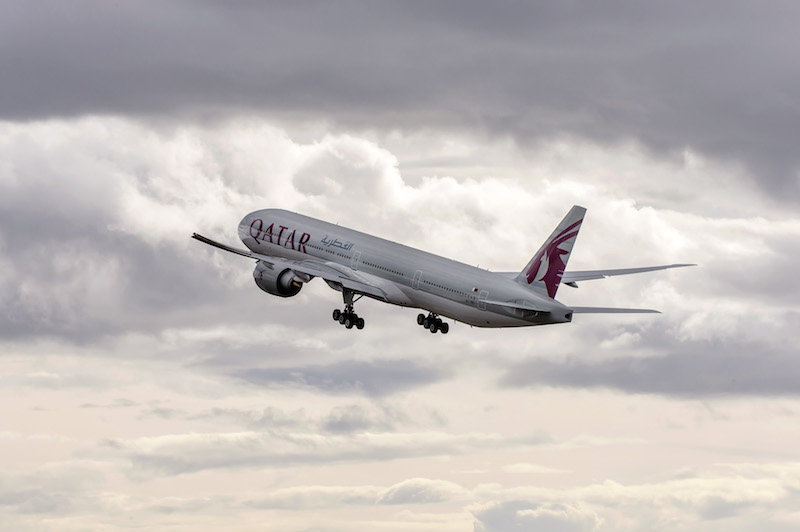Qatar Airways to become the first Airline to meet ICAO 2021 Flight Tracking Recommendations

Qatar Airways has announced it will be the global launch customer of GlobalBeacon(sm), a technology solution by Aireon LLC and FlightAware, designed to provide up-to-the minute global tracking of all aircraft equipped with Automatic Dependent Surveillance-Broadcast (ADS-B) in 2018, approximately three years before the International Civil Aviation Organization’s (ICAO) recommendation for compliance by 2021.
Announced by ICAO in March of 2016, Global Aeronautical Distress Safety System (GADSS) was created to help improve the ability to detect commercial aircraft in remote locations. The key components of GADSS recommend that aircraft report their position to the airline’s operations centre at a minimum of once every 15 minutes under normal flight circumstances. However, if an aircraft should become in distress, position reports are then to be provided every minute. GlobalBeacon will provide a permanent minute-by-minute reporting capability, far exceeding the ICAO recommendation.
Qatar Airways Group Chief Executive, His Excellency Mr. Akbar Al Baker, said: “As one of the fastest growing airlines in the world, both our needs, and our drive to deliver the very best services for our global passengers, are continually evolving. GlobalBeacon will seamlessly integrate with our existing ICAO 2018 compliant flight watch technology (Total Operations System), and further enhance our fleet management by providing updates every minute.
“I am proud of Qatar Airways’ leadership in this vital area of aviation safety and awareness. We will be the first airline in the world to have the capability to use worldwide satellite air surveillance to support our airline operations and to achieve the highest level of flight tracking standards ahead of the ICAO 2021 mandate.”
GlobalBeacon combines FlightAware’s worldwide flight tracking information, including origin, destination, flight plan route, position, and estimated time of arrival with data from Aireon’s space-based ADS-B aircraft surveillance system, due to be operational in 2018. The solution will provide Qatar Airways with state-of-the-art technology to meet and exceed GADSS requirements and recommendations.
In May, Qatar Airways announced the successful completion of its TOPS fleet management system, designed to optimally schedule aircraft and manage flights. TOPS, which stands for Total OPerations System, integrates data from multiple sources and produces a holistic view of the airline’s operation, from the global scale to the individual flight level, in order to anticipate and notify operations staff of any potential issue and provide solution options. Specific tasks that can now be carried out due to this integration include, but are not limited to: tail assignment optimiser, whereby aircraft are assigned to specific lines of flying with respect to the operational needs of the route, based on the specific aircraft’s capabilities; NOTAM manager, where Notice to Airmen are immediately communicated to the specific dispatchers and operations staff for more perfect situational awareness; and Flight Watch, which consolidates all flight data into a single graphical source for ease of tracking, communicating with and managing the airline’s more than 500 daily flights to more than 150 destinations in six continents.
“Qatar Airways is a leader in the aviation industry, and their proactive approach to implementing the GADSS recommendations reinforces that point,” said Aireon CEO, Don Thoma. “With a modern fleet of 190 aircraft flying all over the world, across remote and oceanic airspace, Qatar Airways and GlobalBeacon are an ideal match and no new avionics will be required. We’re excited to welcome them as a partner.”
In addition to aircraft tracking and location reporting requirements, GADSS requires aircraft to provide immediate notification of abnormal events, regardless of air traffic unit boundaries and without a degradation of baseline search and rescue services. Further, distressed aircraft status tracking under GADSS can be activated by the pilot, automatically by the aircraft and remotely by the operations control centre.
“With GlobalBeacon, Qatar Airways is getting the most state-of-the-art solution to meet GADSS recommendations in the industry,” said FlightAware CEO, Daniel Baker. “The adoption of this solution shows their commitment to their customers, employees and international community to help improve airlines and aviation stakeholder’s ability to locate aircraft in distress and improve search and rescue capabilities.”
Qatar Airways will also integrate FlightAware’s Firehose application programming interface (API) with their existing visualisation tool in their flight operations center. Firehose provides secure TCP-based streaming flight positions and flight status data via a combination of worldwide air traffic control data, ADS-B, Mode S multilateration (MLAT), and aircraft datalink information.
Aireon’s space-based ADS-B service will be operational in 2018, shortly after the completion of the Iridium NEXT satellite constellation. The constellation will consist of 66 operational low-earth-orbit satellites providing global coverage. The service will also provide Air Navigation Service Providers with global aircraft surveillance capability, and is expected to help reduce fuel costs, increase safety and enable more efficient flight paths.
